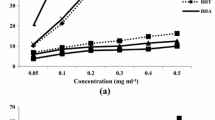Abstract
Inhibitory effects of compounds with guaiacyl and syringyl structure, representing the structure of native lignin, were studied on model cultures of bacteria, yeasts, yeast-like microorganisms and moulds. Isoeugenol exhibited the most pronounced inhibitory effect on growth of the studied microorganisms.
Similar content being viewed by others
References
Akhmedov N. A., Fakhrutdinov S. F.: Antibacterial action of some alkaloids, p. 245 inFarmakologija Alkaloidov i Glikozidov (I. K. Kamilov, Ed.). (In Russian.) Publ. House Fan, Tashkent, USSR, 1967.
Allen C. F. H., Byens J. R.: A synthesis of coniferyl alcohol and coniferyl benzoate.J.Am.Chem.Soc. 71, 2683 (1949).
De Greef J. A., Van Sumere C. F.: Effect of phenolic aldehydes, phenolic acids, coumarins and related compounds on the growth ofSaccharomyces cerevisiae.Arch.Int.Physiol.Biochim. 74, 512 (1966).
Freudenberg K., Dietrich H.: Synthese desd, l-Pinoresinols und andere Versuche im Zusammenhang mit dem Lignin.Chem.Ber. 86, 1157 (1953).
Kulik G. V., Rotmistrov M. M., Bredkhina A. M., Skrinik E. M., Kovtun V. O.: Antimicrobial activity of products of the condensation of some alkyl pyridines with aromatic aldehydes.Mikrobiol.Zh. (Kiev)30, 361 (1968).
Kulka M., Hibbert H.: Studies on lignin and related compounds. LXVII. Isolation and identification of 1-(4-hydroxy-3,5-dimethoxyphenyl)-2-propanon and 1-(4-4-hydroxy-3,5-dimethoxyphenyl)-2-propanon and 1-(4-hydroxy-3-methoxyphenyl(-2-propanon from maple wood ethanolysis products. Metabolic changes in lower and higher plants.J.Am.Chem. Soc.65, 1980 (1943).
Leopold B.: Aromatic keto and hydroxy-polyethers as lignin models III.Acta Chem.Scand. 4 1523 (1950).
Miyao Shigeo: Inhibitory effects of ethanol extracts of mace and eugenol on the growth of microorganisms isolated from vienna sausages.Shokuhin Eiseigaku Zasshi 16, 412 (1975).
Muenzing H. P., Schels H.: Possibilities of replacement of preservative in cosmetics by essential oilsJ.Soc.Cosmet.Chem. 23, 841 (1972).
Telysheva G. M.,Sergeeva V. N.,Gavare L.: Fungicidal properties o alkali oxidation destruction products of lignin.Latv.PSR Zinat.Akad.Vestis, Kim. Ser. 117 (1968).
West K. A., Hibbert H.: Studies on lignin and related compounds. LXIV. Synthesis and properties of 3-hydroxy-l-(4-hydroxy-3-methoxyphenyl)-l-propanon.J.Am.Chem.Soc. 65, 1170 (1943).
Zemek J., Linek K.: Antibacterial effects of some sugar hydrazones.Folia Microbiol. 22, 237 (1977).
Author information
Authors and Affiliations
Rights and permissions
About this article
Cite this article
Zemek, J., Košíková, B., Augustín, J. et al. Antibiotic properties of lignin components. Folia Microbiol 24, 483–486 (1979). https://doi.org/10.1007/BF02927180
Received:
Issue Date:
DOI: https://doi.org/10.1007/BF02927180




